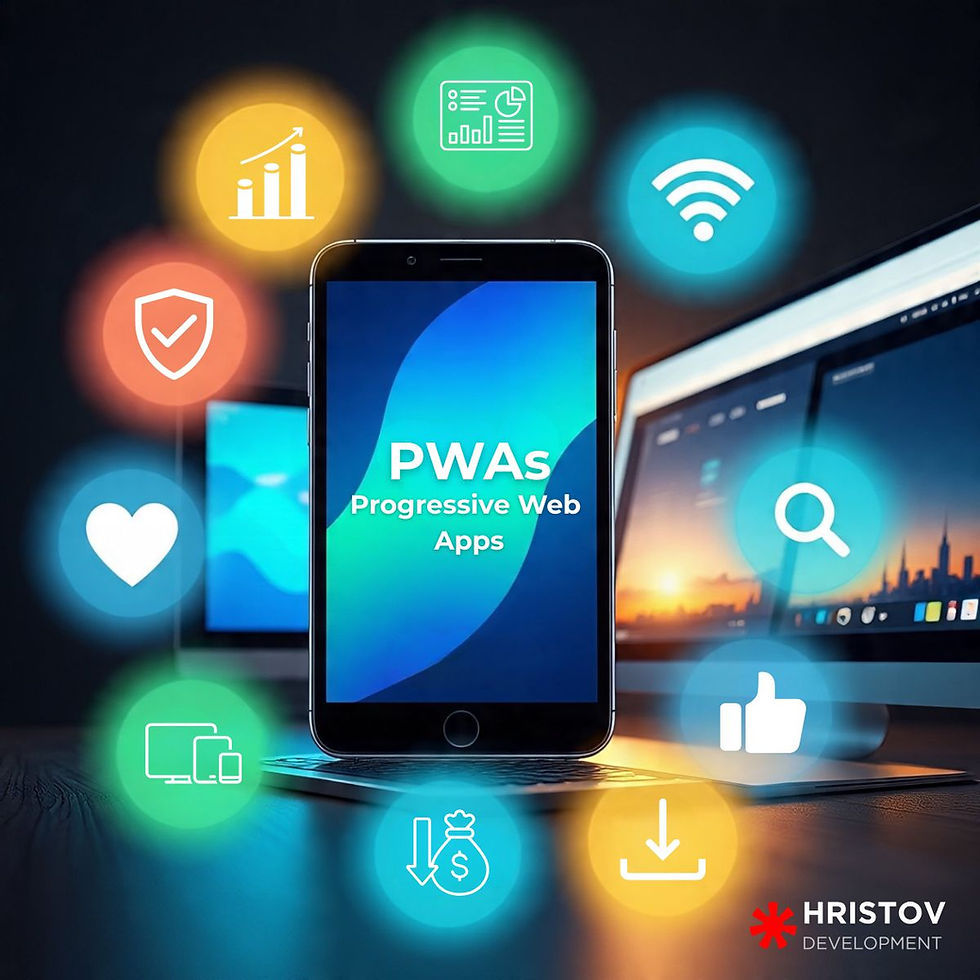From Websites to PWAs: The Evolution of Mobile Experiences
- Elo Sandoval

- Sep 5
- 4 min read
Updated: Sep 25
In the fast-paced world of software development, staying ahead of digital trends is not just a competitive advantage—it’s a necessity. Over the past decade, we’ve witnessed a remarkable evolution in how users access content on mobile devices, moving from traditional websites to sophisticated Progressive Web Apps (PWAs). For startups, SaaS companies, and tech decision-makers, understanding this shift is critical for startup scalability, SaaS growth, and integrating AI-powered experiences seamlessly.

The Early Days: Static Websites and the Mobile Dilemma
It wasn’t long ago that a “mobile experience” meant shrinking a desktop website to fit a smartphone screen. Early mobile websites were essentially condensed versions of their desktop counterparts—functional, yes, but often frustrating for users. Slow loading times, clunky navigation, and limited offline access made it challenging to deliver a smooth experience.
Take, for example, an early e-commerce startup that launched in 2012. Their website was optimized for desktop, and their mobile users frequently abandoned their carts due to slow load times. The lesson was clear: mobile users expect speed, reliability, and convenience, not just access to your content.
Enter Native Apps: Solving Performance, but at a Cost
To address mobile frustrations, many companies turned to native apps. These apps offered faster performance, offline functionality, and push notifications, creating a more engaging user experience. For SaaS companies looking to scale, native apps became a powerful tool to increase user retention and engagement.
However, the approach came with trade-offs:
High development costs: Separate apps for iOS and Android often required two development teams.
Maintenance complexity: Frequent OS updates meant constant app updates.
Distribution hurdles: Users had to discover and download the app from an app store, creating friction in the conversion funnel.
Despite these challenges, native apps laid the groundwork for the next evolution: PWAs.
The Rise of PWAs: Bridging Web and App Experiences
Progressive Web Apps emerged as a game-changer in mobile experiences. A PWA is essentially a website enhanced with app-like capabilities, such as offline access, push notifications, and fast loading, all while being discoverable through standard web browsers.
Consider Starbucks as a real-world example. Their PWA delivers a native app-like experience without requiring users to download anything. Customers can browse the menu, customize orders, and even access offline functionality—all from their browser. The result? Starbucks reported that their PWA loads 2x faster than their previous mobile site and has led to a significant increase in order completion rates.
Why PWAs Matter for Startups and SaaS Companies
Cost-efficiency: One PWA can serve all platforms—iOS, Android, and desktop—reducing development and maintenance costs.
Scalability: PWAs can scale effortlessly as your user base grows, which is critical for SaaS products looking to expand globally.
Improved SEO and discoverability: Unlike native apps, PWAs are indexed by search engines, enhancing organic reach.
Enhanced engagement: Features like push notifications help maintain a connection with users, increasing retention.
AI integration opportunities: With web technologies like JavaScript frameworks and APIs, AI-powered personalization, chatbots, and predictive analytics can be embedded directly in PWAs, offering smart, tailored experiences.
PWAs in Action: Real-World Case Studies
Twitter Lite: Launched to cater to markets with limited connectivity, Twitter Lite is a PWA that loads in less than 5 seconds on 3G networks. User engagement increased dramatically, and data consumption dropped by 70%, illustrating how PWAs enhance accessibility and retention simultaneously.
AliExpress: The e-commerce giant reported a 104% increase in conversion rates from users engaging with their PWA compared to their previous mobile website. Offline capabilities, push notifications, and fast load times contributed to a seamless shopping experience.
These examples demonstrate that PWAs are not just a cost-saving alternative—they’re a strategic tool for growth, particularly for startups and SaaS platforms seeking rapid adoption and global reach.
AI Integration in PWAs: The Next Frontier
The combination of AI integration and PWAs is transforming mobile experiences. AI-driven features like predictive search, personalized recommendations, and chatbots can now be delivered directly through a browser-based interface.
Imagine a SaaS productivity app:
Users open the PWA and are greeted by an AI-powered assistant suggesting tasks based on past behavior.
Predictive analytics forecast the next steps in workflow automation.
Push notifications are context-aware, only alerting users when relevant.
By combining PWA capabilities with AI, startups can deliver enterprise-grade mobile experiences without the overhead of native app development, ensuring scalable, efficient, and highly personalized interactions.
The Future of Mobile Experiences
As we move forward, PWAs are positioned to redefine how software products are accessed and consumed on mobile devices. For decision-makers in the software industry, embracing PWAs is no longer optional—it’s strategic.
Key takeaways for companies considering PWAs:
Focus on performance and offline access; these features drive retention.
Integrate AI features that enhance user engagement and personalization.
Leverage the cost-effectiveness of a single PWA for multiple platforms.
Continuously measure user engagement metrics to iterate and improve experiences.
With these strategies, your startup or SaaS platform can scale faster, improve conversion rates, and deliver mobile-first experiences that users love.
Conclusion
From static websites to PWAs, the evolution of mobile experiences is a story of innovation, efficiency, and user-centric design. For startups and SaaS companies, embracing PWAs—especially when enhanced with AI—offers a pathway to cost-efficient scalability, improved engagement, and global reach.
The message is clear: the future of mobile experiences is fast, reliable, intelligent, and universally accessible—and PWAs are leading the charge.





Comments